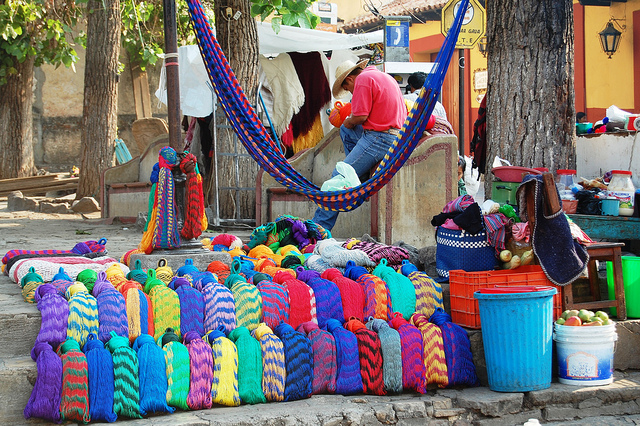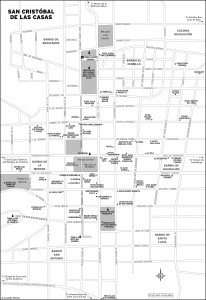
Handicrafts for sale in San Cristóbal de Las Casas. Photo © tatogra, licensed Creative Commons Attribution Share-Alike.

San Cristóbal de las Casas
San Cristóbal de las Casas is a city of many layers, a place to delve into, not merely admire. It is first and foremost a wonderful old colonial town, easily one of Mexico’s finest. Low colorful buildings with tile roofs and wrought-iron details line the narrow streets, their wooden doorways sometimes framed by exuberant bougainvillea vines. The shady central plaza is flanked by an elegant mustard-yellow cathedral that seems to glow in the setting sun, often to the sound of a live marimba band.But San Cristóbal is more than just a pretty face. The indigenous presence is stronger and more visible here than in any other Mexican city. You’ll hear Tzotzil and Tzeltal on a daily basis, and share the streets, markets, and public plazas with indigenous people, a great many wearing traditional garb. Beyond San Cristóbal are numerous outlying villages that can be visited by tour or on your own—from the fiercely independent San Juan Chamula to the little-visited communities of Chenalhó and Oxchuc. A highlight for many visitors, these towns are a reminder of the rich ethnic and cultural diversity of modern Maya society.
San Cristóbal’s non-indigenous population tends to be progressive and bohemian, as are the majority of foreign travelers and expats. The city boasts numerous art-house theaters, coffee houses, and hipster bars, as well as myriad NGO and research organizations; together they form a unique social milieu that is both thoughtful and a lot of fun.
With so many facets to explore, fascinating sights to take in, and welcoming places to spend the night, you’ll find it easy—almost too easy—to extend your stay.
San Cristóbal de las Casas was founded in 1528 by Spanish captain Diego de Mazariegos following a bloody four-year conquest of the region’s dominant indigenous groups, the Zoques and the Chiapas. Mazariegos originally selected a spot along the steamy Río Grijalva in order to keep an eye on the largest Chiapa settlement a few kilometers distant, but within a month rampant disease forced him to relocate to higher ground and the present location.
The new city was originally called Villareal de Chiapa de los Españoles, the first of many names it would sport over the centuries. In 1535, it was renamed San Cristóbal de los Llanos, after the city’s patron saint, then Ciudad Real de Chiapa just a year later. That name stuck for almost three centuries, until 1829, when city leaders adopted the name Ciudad de San Cristóbal, and finally today’s San Cristóbal de las Casas, in honor of the crusading anti-slavery bishop Bartolomé de las Casas. And so it remained, save a short period in the 1930s and ’40s when it was called Ciudad las Casas (but who’s counting?). Of course, indigenous people had names for this highland valley long before the Spanish did, variations of which are still used today, including Jovel and Hueyzacatlán.
San Cristóbal served as the colonial capital of the Chiapanecan highlands—and the entire region, effectively—through most of the 17th and 18th centuries. But in 1768 Chiapas was divided into two mayoralties, to be governed by San Cristóbal and its lowland rival, San Marcos Tuxtla. San Cristóbal remained the political center, but power was clearly draining to the lowlands, where land that was once ruled by disease-carrying insects was being converted into massive ranches and agricultural estates. The Mexican war of independence further elevated San Marcos, and in 1892 the upstart city—by then known as Tuxtla Gutiérrez—was declared the state capital.
If Chiapas was remote when it was ruled from Guatemala (seat of the Spanish Royal Audience), it was doubly so when incorporated into the new Mexican republic, with its capital in far-off Mexico City. Yet Chiapas is a state rich in natural resources, and for nearly a century the state saw its forests cut and its rivers dammed, while roads, schools, utilities, and other public infrastructure lagged far behind the rest of the nation. Of course, being ignored suited Chiapas’s vast indigenous population quite well, at least to a point—they went on living as they had for centuries. But eventually native communities saw too much land expropriated and lost too much autonomy; the balance was tipped and discontent boiled over in the form of masked Zapatista rebels storming San Cristóbal’s city hall in 1994.
The Zapatista uprising has since faded in memory and San Cristóbal has settled back into a familiar second-city status, with a rich ethnic and cultural mix and a strong anti-establishment streak. Sure, there’s a Burger King across the street from Revolución Café, but San Cristóbal still manages to feel like an off-the-beaten-path destination, a place that exudes beauty and intelligence in equal measure.
You’re sure to want at least three days in San Cristóbal, and most travelers would have no trouble staying twice that long, or more. Take a day or two to hit the city’s “obvious” sights, including museums, churches, plazas, and markets, which are numerous and fascinating. Spend another day or two visiting the outlying indigenous villages; San Juan Chamula and Zinacantán are must-sees, but a visit to one or more of the lesserknown communities has its own, often more sublime, reward. And be sure to budget some time to simply soak up San Cristóbal’s atmosphere, whether lounging in the central plaza, writing postcards at a coffee house, catching a documentary at an art-house theater, or enjoying live music and a drink at a local bar.
San Cristóbal’s main pedestrian walkway, known as el andador, runs though the heart of downtown, with the zócalo and cathedral in the middle, and Santo Domingo church and the Templo Carmen archway on its northern and southern ends. Almost 10 blocks long, the walkway is lined with shops and restaurants, and is always pleasantly busy. (Note: The northern section is technically Avenida 20 de Noviembre, and the southern section is Av Miguel Hidalgo, though few people refer to either as such.) The first three blocks of Real de Guadalupe (extending east from the zócalo) are also a pedestrian walkway, though el andador always refers to the original.
Want more info? Read “Getting To and Around San Cristóbal de Las Casas.”×Excerpted from the First Edition of Moon Chiapas.